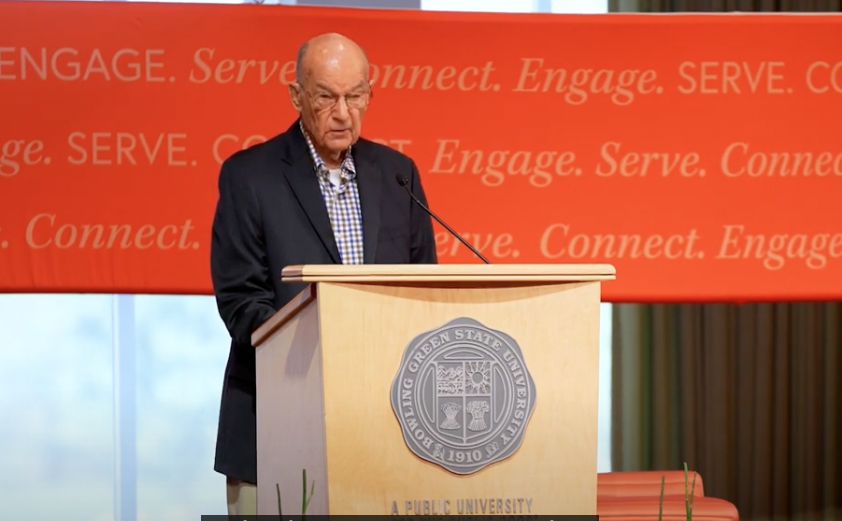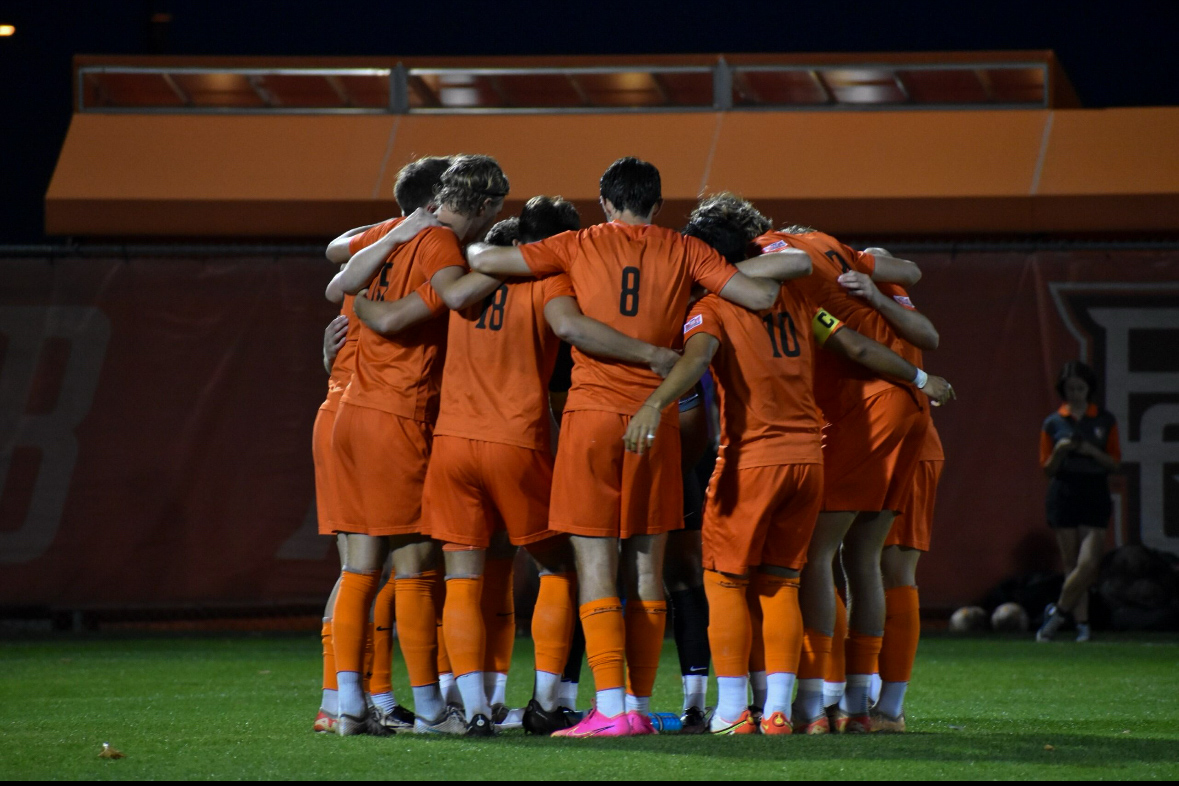While students balance activities such as classes, assignments, tests, work, internships, sleep and finding time to partake in activities to reduce stress, one important element of a student’s life may be pushed aside: nutrition.
When there is limited time during the day, grabbing a couple slices of pizza or a hamburger is a quick way to fill a hungry stomach. Even when it’s not the healthiest choice, it certainly is the easiest.
Food that looks good is what Kyle E. Fetter, freshman, seeks out when eating at the campus dining centers. A balanced diet isn’t something Fetter pays much attention to.
Craig S. Wood, sophomore, said when selecting meals he thinks about not only the way food tastes but whether or not it would be bad for him.
“If it’s too bad, I won’t eat it,” he said. Wood believes that there is too much fried food at the dining center in McDonald, where he resides.
Persistent challenges to eating healthy on and off-campus in Bowling Green will always be there. For one thing, the temptation of those tasty, high-calorie and high-fat foods are at every dining facility on and off campus.
Bowling Green restaurants with an abundance of healthy choices seem to drown out in the high number of fast food restaurants, sports bars and pizza places. Despite a high number of fast foods in Bowling Green, “there is always a healthier option available,” said Vonda Hetherington, dietitian manager at the Wood County Hospital.
A 2003 study conducted by the American College Health Association estimates that 24.7 percent of college females and 39.6 percent of college males are overweight or obese. This measure is taken by body mass index with relation to weight and height.
The health problems associated with obesity, according to the American Obesity Association, include: heart disease, diabetes, high blood pressure, high cholesterol, certain cancers, gallbladder disease, certain kinds of arthritis and respiratory disease.
The number of diabetes cases has sky-rocketed to the point where it’s being called an epidemic, said Hetherington. The American Diabetes Association says 20.8 million Americans are diagnosed with diabetes and an estimated 6.2 million more have it, but do not know.
While type 1 diabetes is linked to family history, type 2 has been linked to inactive and overweight individuals, Hetherington said. Links between some fruits, whole grains, and vegetables and the prevention of diabetes, heart disease and even some cancers have recently being detected, Hetherington said.
Hetherington tailors a patient’s diet plan according to individual lifestyle. Nutrition education is available when needed but it’s “a hard bridge from knowledge to behavior,” she said
The University offers free nutrition services to students who want to learn more about living healthy. Joanne Perez-Vergara, senior associate director of University Dining Services along with Daria Blachowski-Dryer, both registered dietitians, can help students identify with a healthier lifestyle though better food choices, moderation and exercise.
Perez-Vergara and Blachowski-Dryer are there to assist the general managers on any concerns or questions they have for menu plans at the campus dining facilities. There are two menu cycles, one for spring and one for fall, which are planned a semester in advance. Perez-Vergara says they “always try to have healthier options” available to students.
Though the general managers at the dining facilities put together the menus, it is ultimately reviewed by the associate director of operations. Perez-Vergara says they strive to “meet all the food groups in an adequate way.”
She said they are also conscientious of what students actually buy: fries, burgers and chicken nuggets, for example. When planning the menu, the top selling foods, student feedback, the food groups and raw food costs are all taken into account, according to Perez-Vergara.
Perez-Vergara said quality of food, not limited to the healthful foods, is where the price differences are on campus. She said price differences also come with paying for convenience.
Off-campus students with a tight budget and time restraints could find it challenging to balance between the two. For example, a head of lettuce that needs to be cleaned and prepared costs only $0.99 cents at Kroger’s, while bagged lettuce already washed and prepared can cost $2.99 at regular price.
Paying for convenience is also seen at Kroger’s in the differences between deli sliced chicken breast costing $7.99 per pound while raw, boneless, skinless chicken breasts cost only $4.99 per pound. As a student, tight schedules can be a restraint to finding a healthy meal or having to cook and prepare one at home.
Perez-Vergara says that University Dining Services is currently working on making daily menu items at all the dining facilities available online. Since the same thing is not offered at every dining hall, exploration is currently the only way to find the food students are seeking.
Nate Weaver, sophomore, would prefer to have a dining facility more like what Kreischer and Founders have than at McDonald, where he resides. Weaver finds it to be a hassle to eat at Kreischer regularly and typically will only go there when he is on the way to the rec.
The first issue of Vegetarian Journal in 2003 contained a Scientific Update by Reed Mangels who says “young adults especially are establishing dietary patterns, independent of their parents that may persist for the rest of their adult years.”
Early adulthood doesn’t seem like the time to worry about the health problems that come later in life, especially while trying to get through school. The importance of diet and nutrition go beyond just getting in shape for spring break, even at a young age.
Hetherington mentions that people only build bone density until around the age of 30, which requires proper nutrition and exercise.
“Once you hit 30, what you have is what you get for the rest of your life.” This is especially important for women since the risk of osteoporosis is much higher than in men.
There is also the recent evidence that early stages of artery-clogging plaques are starting as young as 10 and 14-years-old. “Just because someone can maintain their weight and work it off doesn’t necessarily mean they can eat” those unhealthy fats in their diets. They still could be depositing plaque in their arteries and never know it until 20 or 30 years down the road,” Hetherington said.
The American Cancer Society estimates that one-third of cancer deaths could be prevented if “Americans ate a healthy, balanced diet that emphasized plant foods and helped maintain a healthy weight.” This is based on evidence from state-of-the-art research on diets based on plant foods such as fruits, vegetables and whole grains.
While simply being on a college campus can help students maintain an active lifestyle, it is only temporary. Long hikes from the parking lot or dashing from one end of campus to the other to get to class can certainly help fit exercise into busy schedules. This is inevitably going to change after graduation, which will require adjustments.
“Everybody’s metabolism slows down every year we age,” Hetherington said. Although homework won’t be a block to a healthy lifestyle after graduation, juggling a 40-hour work week and home life won’t make it any easier, according to Hetherington.


















